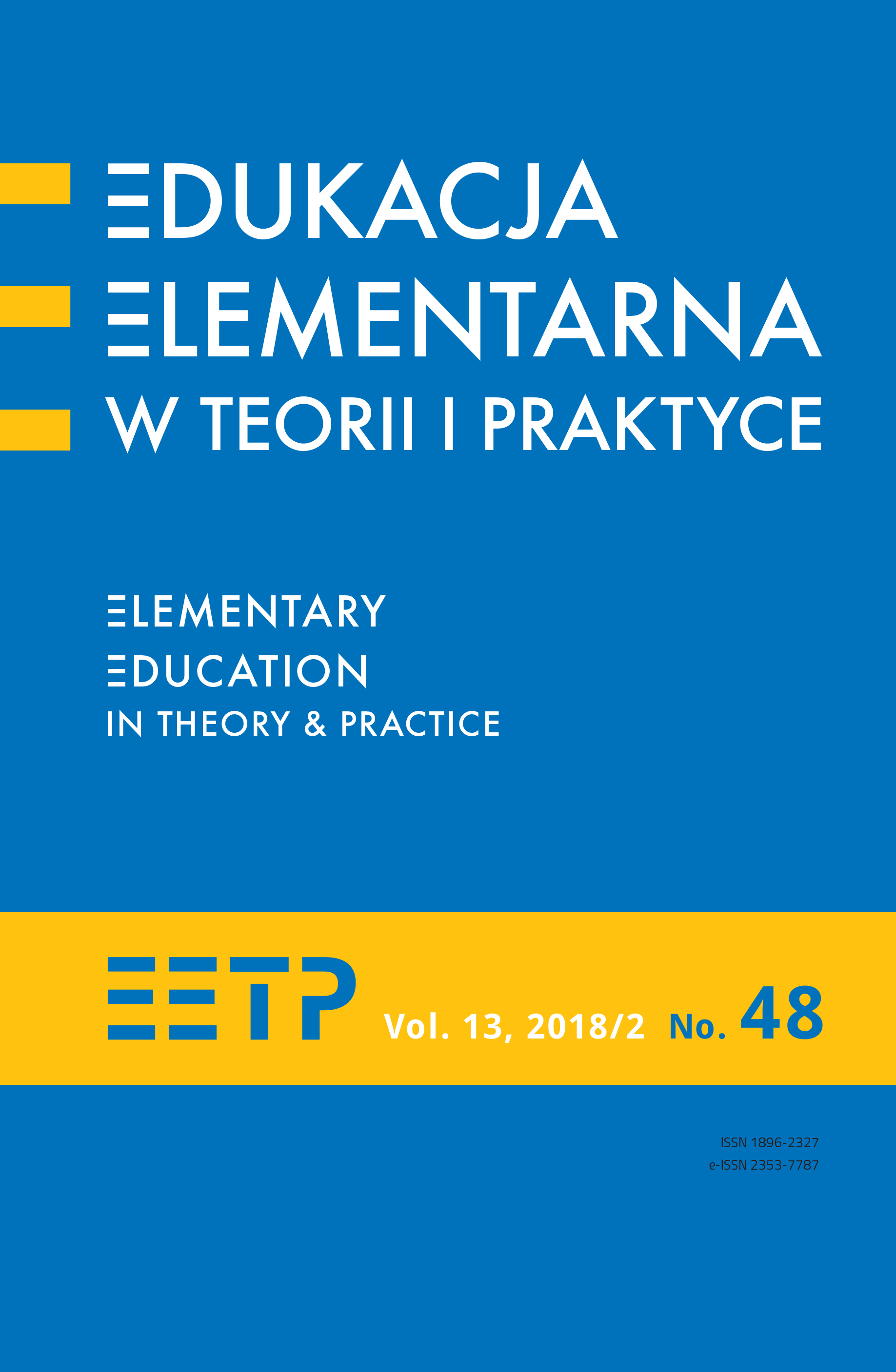W poszukiwaniu ciekawych programów rozwijania aktywności twórczej dzieci
Abstrakt
Jednym z ważnych zadań nauczyciela w edukacji wczesnoszkolnej jest tworzenie środowiska sprzyjającego rozwojowi twórczej aktywności dziecka, która ujawnia się w spontanicznej lub inspirowanej aktywności zabawowej, graficznej, werbalnej, muzycznej oraz ruchowej. Troska o rozwijanie kreatywności, o jej zakorzenienie w praktyce edukacyjnej, wydaje się ważnym zadaniem szkoły i jednym z najpilniejszych wyzwań współczesnego nauczyciela, dlatego w prezentowanej publikacji podjęto próbę analizy tekstów programów przeznaczonych do rozwijania twórczej aktywności dzieci pod kątem celów, zasad, treści i sposobów realizacji. Badaniu poddano trzy publikacje: Program edukacyjny Żywioły. Lekcje twórczości w nauczaniu zintegrowanym Jolanty Bonar i Krzysztofa J. Szmidta; Podróże, skarby, przygoda. Podręcznik i program rozwijania twórczości, samoświadomości oraz dyspozycji autokreacyjnych dzieci klas I–III Janiny Uszyńskiej-Jarmoc, oraz Krok w kierunku kreatywności. Program stymulowania twórczości na etapie edukacji przedszkolnej i wczesnoszkolnej Marioli Jąder. Z analizy programów wynika, że doskonale wpisują się one we współczesny nurt kształcenia zintegrowanego, uwzględniają bowiem zarówno integrację celów, jak i treści, form ekspresji oraz metod wspierania aktywności twórczej dzieci, a także proponują oryginalne zasady pracy z dziećmi.
Bibliografia
Bałachowicz J., Adamek I., Zakończenie, [w:] Kreatywność jako wymiar profesjonalizacji przyszłych nauczycieli wczesnej edukacji, red. J. Bałachowicz, I. Adamek, Wydawnictwo Akademii Pedagogiki Specjalnej, Warszawa 2017.
Jąder M., Krok… w kierunku kreatywności. Program stymulowania twórczości na etapie edukacji przedszkolnej i wczesnoszkolnej, Wydawnictwo Impuls, Kraków 2005.
Marek E., Pedagogiczna interpretacja założeń konstruktywizmu w świetle analizy wybranych programów kształcenia zintegrowanego, [w:] Niektóre problemy wczesnej edukacji, red. K. Żegnałek, Pracownia Wydawnicza Wydziału Humanistycznego, Siedlce 2016.
Podstawa programowa kształcenia ogólnego dla szkoły podstawowej, Załącznik nr 2 do Rozporządzenia Ministra Edukacji Narodowej z dnia 14 lutego 2017 r. w sprawie Podstawy programowej wychowania przedszkolnego oraz Podstawy programowej kształcenia ogólnego dla szkoły podstawowej, Dziennik Ustaw Rzeczpospolitej Polskiej, poz. 356.
Szmidt K.J., Pedagogika twórczości, Gdańskie Wydawnictwo Psychologiczne, Gdańsk 2007.
Szmidt K.J., Bonar J., Żywioły. Lekcje twórczości w nauczaniu zintegrowanym, WSiP, Warszawa 1998.
Uszyńska-Jarmoc J., Podróże, skarby, przygoda. Podręcznik i program rozwijania twórczości, samoświadomości oraz dyspozycji autokreacyjnych dzieci klas I–III, Trans Humana, Białystok 2005.
Uszyńska-Jarmoc J., Twórcza aktywność dziecka. Teoria – rzeczywistość – perspektywy rozwoju, Trans Humana, Białystok 2003.
Copyright (c) 2018 Edukacja Elementarna w Teorii i Praktyce

Utwór dostępny jest na licencji Creative Commons Uznanie autorstwa – Bez utworów zależnych 4.0 Międzynarodowe.
1. Autor zgłaszając swój artykuł oświadcza, że jest Autorem artykułu (zwanego dalej Utworem) i:
- przysługują mu wyłączne i nieograniczone prawa autorskie do Utworu,
- jest uprawniony/a do rozporządzania prawami autorskimi do Utworu.
Oświadcza, że nie narusza praw autorskich osób trzecich i praw prawnych.
Oświadcza, że nie występuje żaden konflikt interesów.
2. Udziela Uniwersytetowi Ignatianum w Krakowie nieodpłatnej, niewyłącznej, nieograniczonej terytorialnie licencji do korzystania z Utworu na następujących polach eksploatacji:
- utrwalania utworu w formie papierowej, a także na nośniku cyfrowym lub magnetycznym;
- zwielokrotnienia utworu dowolną techniką, bez ograniczenia ilości wydań i liczby egzemplarzy;
- rozpowszechniania utworu i jego zwielokrotnionych egzemplarzy na jakimkolwiek nośniku, w tym wprowadzenia do obrotu, sprzedaży, użyczenia, najmu;
- wprowadzenia utworu do pamięci komputera;
- rozpowszechniania utworu w sieciach informatycznych, w tym w sieci Internet;
- publicznego wykonania, wystawienia, wyświetlenia, odtworzenia oraz nadawania i reemitowania, a także publicznego udostępniania utworu w taki sposób, aby każdy mógł mieć do niego dostęp w miejscu i czasie przez siebie wybranym;
- w zakresie praw zależnych do Utworu, obejmujących w szczególności prawo do dokonania koniecznych zmian w Utworze, wynikających z opracowania redakcyjnego i metodycznego, a także do dokonania tłumaczenia Utworu na języki obce.
Udzielenie licencji następuje z chwilą przekazania Utworu na rzecz Uniwersytetowi Ignatianum w Krakowie. Uniwersytet Ignatianum w Krakowie jest uprawniony do udzielania dalszych sublicencji do Utworu, w zakresie udzielonego prawa. Licencja jest ograniczona czasowo i zostaje udzielona na okres 15 lat, licząc od daty jej udzielenia.
Wyraża się zgodę i zachęca autorów do publikacji ich tekstu w Internecie (np. w repozytorium instytucji lub na jej stronie internetowej) przed lub podczas procesu składania tekstu jako, że może to prowadzić do korzystnych wymian oraz wcześniejszego i większego cytowania opublikowanego tekstu (Patrz The Effect of Open Access). Zalecamy wykorzystanie dowolnego portalu stowarzyszeń badawczych z niżej wymienionych:




